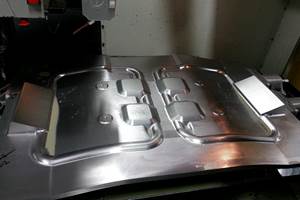Buying a Grinder: The Abrasive Process
The prospective buyer of a new grinding machine should be aware of the ins and outs of the abrasive process, how abrasive bonds work and the various forms of wheel dressing.
Share






In last post on the subject of grinding machines, we talked about the basic appeal of grinders and how they are constructed. Now, we look closely at how the abrasive process works and what it means for the shop owner in the market for a new machine.
An Abrasive Process
Grinding is an abrasive machining process that uses a grinding wheel as the cutting tool. A grinding wheel consists of hard, sharp-edged particles. When the wheel spins, each particle acts like a single-point cutting tool.
Grinding wheels are available in a multitude of sizes, diameters, thicknesses, grit sizes and bonds. Abrasives are measured in grit or particle size and range from 8-24 grit (coarse), 30-60 (medium), 70-180 (fine) and 220-1,200 (very fine). Coarser grades are used where relatively high volumes of material must be removed. Finer grades are generally used after a coarser grade to produce a smoother surface finish.
Grinding wheels are made from a variety of abrasive materials including silicon carbide (generally used for non-ferrous metals); aluminum oxide (used for ferrous high-tensile-strength alloys and wood; diamond (used for ceramic grinding or final polishing); and cubic boron nitride (generally used for steel alloys).
Abrasives can be further classified as bonded, coated or metal-bonded. Bonded abrasives consist of abrasive grits that have been mixed with binders and then pressed into the shape of a wheel. They are fired at a high temperature to form a glassy matrix, commonly known as vitrified abrasives. Coated abrasives are made of abrasive grits bonded with resin and/or glue to flexible substrates such as paper or fiber. This method is most often used for belts, sheets and flap disks. Metal-bonded abrasives, most notably diamond, are held together in a metal matrix in the form of a precision wheel. The metal matrix is designed to wear away to expose the abrasive media.
Wheel Dressing
During the grinding process, the abrasive wheel can wear, become dull, lose its profile form or “load up” as swarf or chips stick to the abrasive. Then, rather than cutting, the abrasive wheel begins rubbing the workpiece. This condition creates heat and reduces the effectiveness of the wheel. When the wheel loads up, chattering will occur, and the workpiece surface finish will be affected. Cycle times will increase. At this point, the wheel must be “dressed” to sharpen the wheel, thereby removing any material lodged on its surface and returning the wheel to its proper form, as well as bringing fresh abrasive grit to the surface.
Many types of wheel dressers are utilized in grinding. Most common is a single-point, static, on-board diamond dresser that sits in a block, usually positioned on the machine’s headstock or tailstock. The face of the grinding wheel is passed over this single-point diamond and a small quantity of the abrasive wheel is removed to sharpen it. Two or three diamond blocks can be used to dress the face, sides and form of the wheel.
Rotary dressing is now becoming a popular method. A rotary wheel dresser is coated with hundreds of diamonds. It is often used in creep-feed grinding applications. Many manufacturers have found rotary dressing to be superior to single-point or cluster dressing for processes that require high part production and/or close part tolerance. With the introduction of vitrified superabrasive grinding wheels, rotary dressing has become a necessity.
A swing dresser is yet another type of dresser that is used for large form wheels which require deeper and longer dressing travel.
Offline dressers are used primarily to sharpen the wheel away from the machine while using an optical comparator to verify form profiles. Some grinding machines use wire EDM to dress metal-bonded grinding wheels still mounted in the grinder.
Related Content
4 Manufacturing Trends That Cannot Be Ignored
The next five years will present their own unique set of challenges, and shops can alleviate them by embracing these technologies and trends.
Read MoreHow to Determine the Currently Active Work Offset Number
Determining the currently active work offset number is practical when the program zero point is changing between workpieces in a production run.
Read More4 Tips for Staying Profitable in the Face of Change
After more than 40 years in business, this shop has learned how to adapt to stay profitable.
Read More6 Machine Shop Essentials to Stay Competitive
If you want to streamline production and be competitive in the industry, you will need far more than a standard three-axis CNC mill or two-axis CNC lathe and a few measuring tools.
Read MoreRead Next
AMRs Are Moving Into Manufacturing: 4 Considerations for Implementation
AMRs can provide a flexible, easy-to-use automation platform so long as manufacturers choose a suitable task and prepare their facilities.
Read MoreMachine Shop MBA
Making Chips and 91±¬ÁĎÍř are teaming up for a new podcast series called Machine Shop MBA—designed to help manufacturers measure their success against the industry’s best. Through the lens of the 91±¬ÁĎÍř benchmarking program, the series explores the KPIs that set high-performing shops apart, from machine utilization and first-pass yield to employee engagement and revenue per employee.
Read More



















